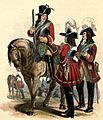Red coat (military uniform) facts for kids

A red coat (sometimes called a scarlet tunic) is a special military uniform. It was worn by many soldiers in the British Army, Royal Marines, and other groups connected to the British Empire from the 1600s to the 1900s. Even today, some armed forces in the Commonwealth of Nations (countries that used to be part of the British Empire) still use red coats for their formal uniforms.
The name "redcoat" might have started in Ireland in the 1500s. British soldiers there wore red coats, and the Irish used the term to describe them. Later, Irish people who moved to America and Europe spread the name.
From the mid-1600s to the 1800s, most British soldiers wore a coat that was a deep red color called "madder red." This was true for most soldiers, except for those in the artillery, rifle units, and some cavalry. After 1873, a brighter red color called "scarlet" became the standard for all ranks. Before that, only officers, sergeants, and some cavalry units wore the brighter scarlet.
Contents
Why Did British Soldiers Wear Red Coats?
The red coat became a famous symbol of the British soldier. It was chosen for several reasons, both practical and symbolic.
Early Red Uniforms: A New Look
Before the 1600s, soldiers often wore their own clothes or uniforms that were not very organized. In 1645, during the English Civil War, a new army called the New Model Army was formed. This army was very important because it was one of the first professional armies in England. They were given red coats, which helped them look like a unified and strong force. This was the first time many British soldiers wore red uniforms together.
Making Red Dye: A Common Color
One reason red was chosen was that the dye was easy to get and not too expensive. A common plant called rubia tinctorum (also known as madder) was used to make the red dye. This made it practical to produce many red uniforms for a large army.
Standing Out on the Battlefield
In the past, battles were often fought in open fields. Soldiers needed to be able to tell their friends from their enemies. Bright colors like red made it easy to spot British soldiers from a distance. Even though it might seem like a bright color would make soldiers an easy target, it also helped commanders see where their troops were during the chaos of a battle.
A Symbol of Power and Bravery
The red coat also became a symbol of the British Empire's power and the bravery of its soldiers. It was a uniform that was recognized around the world. For many years, seeing soldiers in red coats meant seeing the strength of the British military.
When Did Red Coats Stop Being Used in Battle?
By the late 1800s, the world of warfare was changing. New weapons like rifles became more accurate, and smokeless powder meant that gun smoke no longer covered the battlefield. This made bright uniforms like the red coat a big disadvantage. Soldiers in red were easy targets.
Because of these changes, the British Army started to switch to uniforms that blended in with the environment. They began using colors like drab (a dull, brownish-yellow color) for combat uniforms. After 1902, the scarlet tunic was mostly used for parades, ceremonies, and formal events, not for fighting.
Red Coats Today: A Tradition Lives On
Even though red coats are not used in combat anymore, they are still a very important part of military tradition. Many regiments in the British Army, like the Foot Guards, still wear their scarlet tunics for special occasions. You can see them during famous events like the Trooping the Colour parade, which celebrates the King's Official Birthday.
Other countries that have historical ties to Britain also use red uniforms. For example, the Canadian Militia and the Military Knights of Windsor wear red coats. Even the United States Marine Band wears a red uniform for their performances, showing how this historic color has influenced military traditions around the world.
Images for kids
-
Red coats worn by Williamite forces during the Williamite War in Ireland. The Irish referred to soldiers of the Lord Lieutenant of Ireland as red coats as early as 1561.
-
Historical reenactors showing the New Model Army during the Battle of Naseby. The New Model Army was formed in 1645 by the Parliamentarians of the English Civil War.
-
Infantry uniforms of the British Army from 1750 to 1835.
-
Battle of Bunker Hill, painted by Howard Pyle.
-
The rise of rifles and smokeless powder led to the red tunic being phased out of combat in the late 1800s.
-
Officer's uniform for the Royal Foot Guards of the Polish–Lithuanian Commonwealth, 1732.
-
Soldier of the 29th Regiment of Foot, 1742 -
Soldier of the 60th (Royal American) Regiment, 1758 -
Grenadier of the 40th Regiment of Foot, 1767 -
Officer of the 71st Regiment of Foot, 1776 -
Member of the Band of the Royal Regiment of Scotland, 2007 -
Soldiers of the Coldstream Guard and the Royal Gibraltar Regiment, 2012 -
Members of the Royal Canadian Regiment and Prince Philip, 2013 -
Members of the Governor General's Foot Guards, 2017























